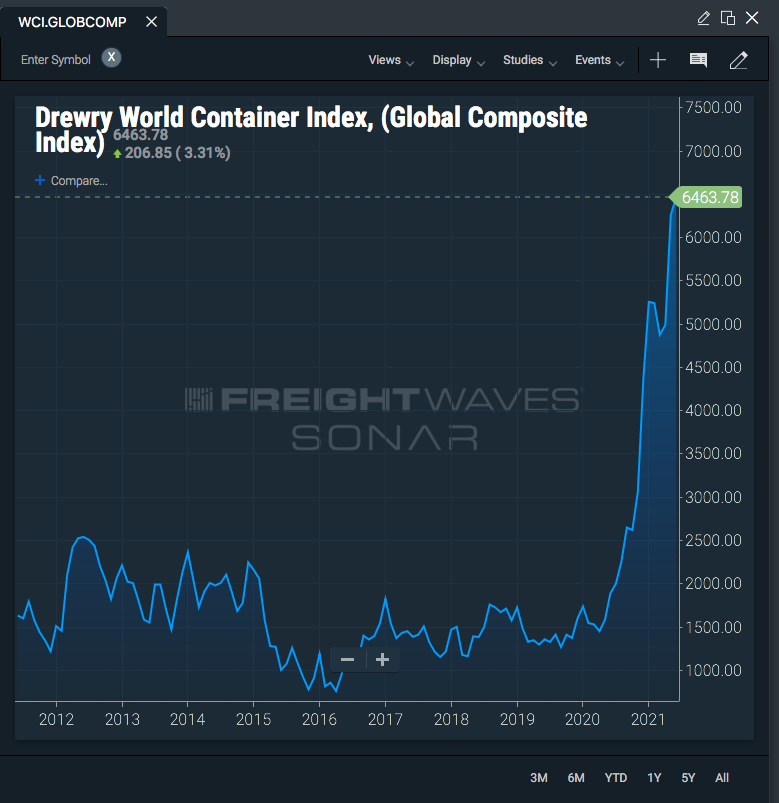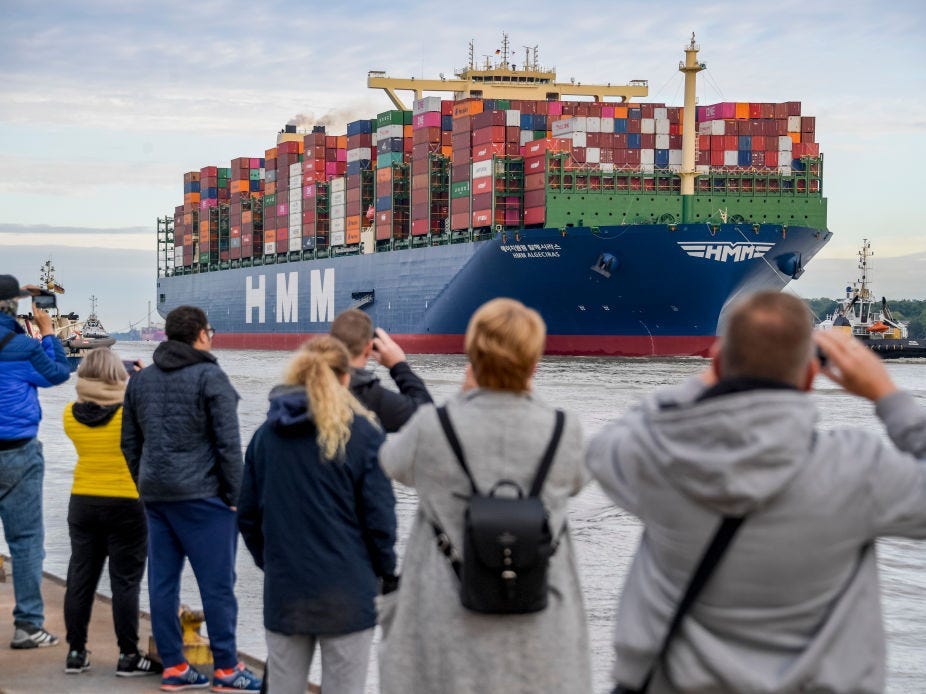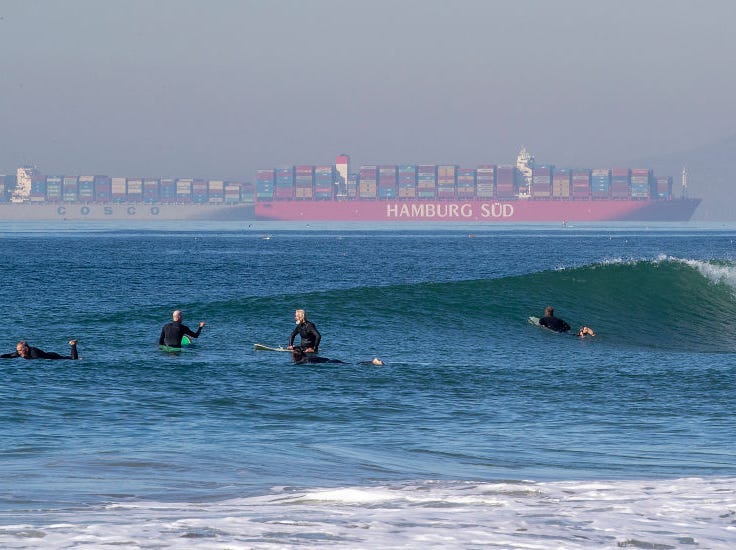- Your favorite brands are paying 10 times the typical price of shipping your stuff across the ocean.
- Shortages also abound.
- It's all thanks to a chaos in maritime trade that's been unfolding since last year.
- See more stories on Insider's business page.
The price for a shipping container is looking a lot like a meme stock.

FreightWaves
The surge in shipping costs points to our shortage of semiconductors, lumber, chicken, chlorine, and, really, "just about everything." The pandemic broke the supply chain last year, and the shipping companies that move stuff all over the world still haven't recovered.
We rely on a complex, global supply chain. It's the reason we can get two-day shipping on ultra-cheap Wayfair furniture built in Vietnam or why seafood caught in the US is so cheap (much of it is actually processed in China before it's shipped back here).
Ocean shipping powers our ability to buy a massive variety of inexpensive stuff. This system needs many things to function, but I'll distill those into a few important elements:
- Massive ocean-faring ships
- Containers on the ships
- Places for the ships to park so that the containers can be unloaded
And, all of those things have broken at some point in the last year and a half! In fact, many of them are still broken. Here's how that happened and why the shortages are still going on.
Our world's weird new megaships
I am a newbie to the world of shipping. So, to better understand what's going on with our current chaos, I chatted with Simon Sundboell, a 20-year veteran of the world of container shipping based in Copenhagen. He's the founder of ocean shipping intelligence firm eeSea.
To understand the shipping debacle, Sundboell took me back to the mid-2000s. Ocean shipping was a more fragmented industry than it is today, and manufacturers and retailers could pit these various firms against each other to win low rates. To reach economies of scale, major ocean carriers began demanding larger ships.

Photo by Axel Heimken/picture alliance via Getty Images
An analysis of the fleet listed on the website of Hapag-Lloyd, which is the world's sixth-largest ocean carrier by volume, makes that clear. I found that the average ship in the German ocean carrier's line built in the 2000s could hold just under 6,400 containers of around 20-feet long. For ships built after 2010, that number nearly doubled to around 11,500.
Sundboell told me that these larger ships did manage to increase profitability for Maersk, MSC, and other major carriers - but margins were tight. Ships couldn't be less than around 90% full in order to keep these carriers in business.
It reminds me of America's bizarrely-long freight trains, which stretched to three miles long in order. On an entirely other note, chicken breasts have increased by 80% over the past few decades (and the birds themselves grow much faster).
In our pre-pandemic times, everything was just getting bigger and bigger! But perhaps we flew too close to the sun.
No ships
The first hit to the world's ocean shipping network came in early spring of last year, Sundboell told me. As the pandemic spread around the globe, it was unclear if factories in Asia would be open, or if consumers globally would even have the ability to buy durable goods. So, they started canceling sailings.
"The carriers are sitting here in March 2020, looking at a market where they have no idea whether the demand side, meaning the containers that go on their vessels, are going to drop by 5%, 15%, 30% or 50%," Sundboell told me. And recall that these companies can't profitably runt their megaships unless they're full.
As a result, carriers started to "blank," or cancel, their sailings. One major shipping alliance announced cutbacks of up to 22% on voyages between Asia and Europe during the spring of 2020. Between Asia and North America, carriers slashed some 20% of capacity.
No parking
A slowdown in manufacturing, and the predictions of an economic meltdown, forced the shipping world into a standstill in the early half of 2020. By the latter half, the world was starting to "turn back on."
Rather than turning frugal, consumers started spending all that cash they had tucked away for travel and restaurants on stuff. It's no secret people started buying treadmills, couches, and hair dye more than ever. That trend is still firing up the US ports that handle our imports. The Port of Los Angeles, which is the United States' largest by volume, broke its first-quarter cargo record this year. The Port of Long Beach, the second largest, handled more cargo than ever last month.

Allen J. Schaben / Los Angeles Times via Getty Images
This unusual boom in volume has helped spark a massive port traffic jam. Let's narrow in on Long Beach and Los Angeles, our country's two biggest ports.
During the first half of 2020, data from the Pacific Merchant Shipping Association showed under 5% of shipments had a dwell time - the time a ship spends at a port rather than at sea - greater than five days. It steadily increased throughout the year. And from October through December of that year, around a quarter of ships were waiting more than five days.
By late January 2021, some 55 vessels were crowded around the LA and Long Beach ports, reportedly sitting in the ocean for up to two weeks. FreightWaves noted that it took longer for some of these ships just to get unloaded than it was for them to cross the Pacific.
Why is there a delay to unload these ships? The boom in demand is, of course, one leading reason. American ports are also seeing a shortage of labor. There's an ongoing shortage of the longshoremen who who undertake the critical task of getting these containers off the ship and onto trucks or trains. Dozens were quarantined due to the coronavirus at varying points last year.
Above all, when something goes astray with ocean shipping, there's a major butterfly effect. A ship that's unloaded two weeks late in Los Angeles is also going to be two weeks late when it arrives back in, say, Chittagong, Bangladesh to load up on IKEA furniture. The ship before that may have been two weeks late, too, so the carrier might just cancel the ship IKEA was expecting space on, Sundboell said. Then IKEA will have to scramble for another way to move your nightstand - and potentially every order they had after that, which will now be pushed down the road.
No containers
Halfway into 2021, the situation has not improved.
-Ryan Petersen (@typesfast) June 10, 2021
There's another shortage giving rise to our shortages: A lack of shipping containers. Or rather, a lack of containers where they need to be.
Some of these containers are being used on ships right now, as Flexport's Ryan Petersen noted on Twitter this week. This includes ships that might be hanging out in the ocean, waiting to dock and get unloaded.
The bigger issue is that many of these containers are not going back to Asia to get reloaded with stuff.
US exports have not kept up with imports from China, our largest trans-Pacific trading partner. According to FreightWaves SONAR data, import volume from China via ocean shipping is up 54% year-over-year. Exports have only ticked up by 4.4%. That means lots of containers are leaving Asia, but not enough have been returning there.

This Starbucks in Shanghai opened in 2020, and is made out of shipping containers. Ugh! We need those containers back!
Until recently, as Petersen explained on a recent episode of Bloomberg's Odd Lots, ocean carriers didn't realize they needed to be carrying more empty containers back than ever. We're still correcting this imbalance of containers, and experts predict it will remain wonky until 2022.
At least the shipping scions are doing well
The dirty secret is that the bottlenecks hampering shipping right now is bad for seemingly everyone except the shipping companies. Should these containers stay in Los Angeles instead of gliding back over to Shanghai, that only reduces ocean shipping capacity... driving freight rates ever higher, and pumping up profits for major ocean cargo lines.
Indeed, these past few years are some of the first in a while that ocean carriers are winning the game. Maersk, for example, turned a profit of $2.9 billion in 2020; it lost money three of the four years preceding 2020.
Shipping companies didn't have the upper hand against the brands whose stuff they carry before the pandemic. Now, Zara, IKEA, and their peers are scrambling for space on one of these ships and willing to pay top dollar, Sundboell told me.

Budrul Chukrut/SOPA Images/LightRocket via Getty Images
That's going to continue to make everything more expensive. Sundboell provided the example of Nike usually paying $2,000 for a 40-foot container full of sneakers. Now, that container might be more around $15,000 to $20,000.
A shoe or apparel manufacturer, like Nike, normally wouldn't fret about the cost of moving your goods across the ocean. "It wasn't something you'd ever worry about," Sundboell told me. "Now suddenly at $20,000, you're starting to see good that within margins that are no longer profitable to even sell it."
Should we prepare for a sneaker shortage now? Get ready, folks...
Let me know what you think of this latest dispatch at [email protected]. What's the next shortage? Do you have any other ideas on what's happening in ocean shipment? Thanks for reading!
